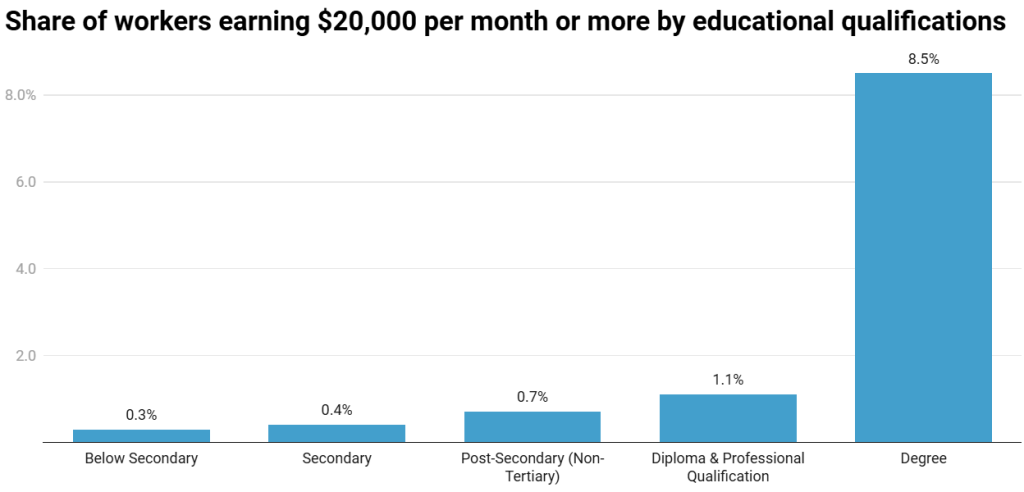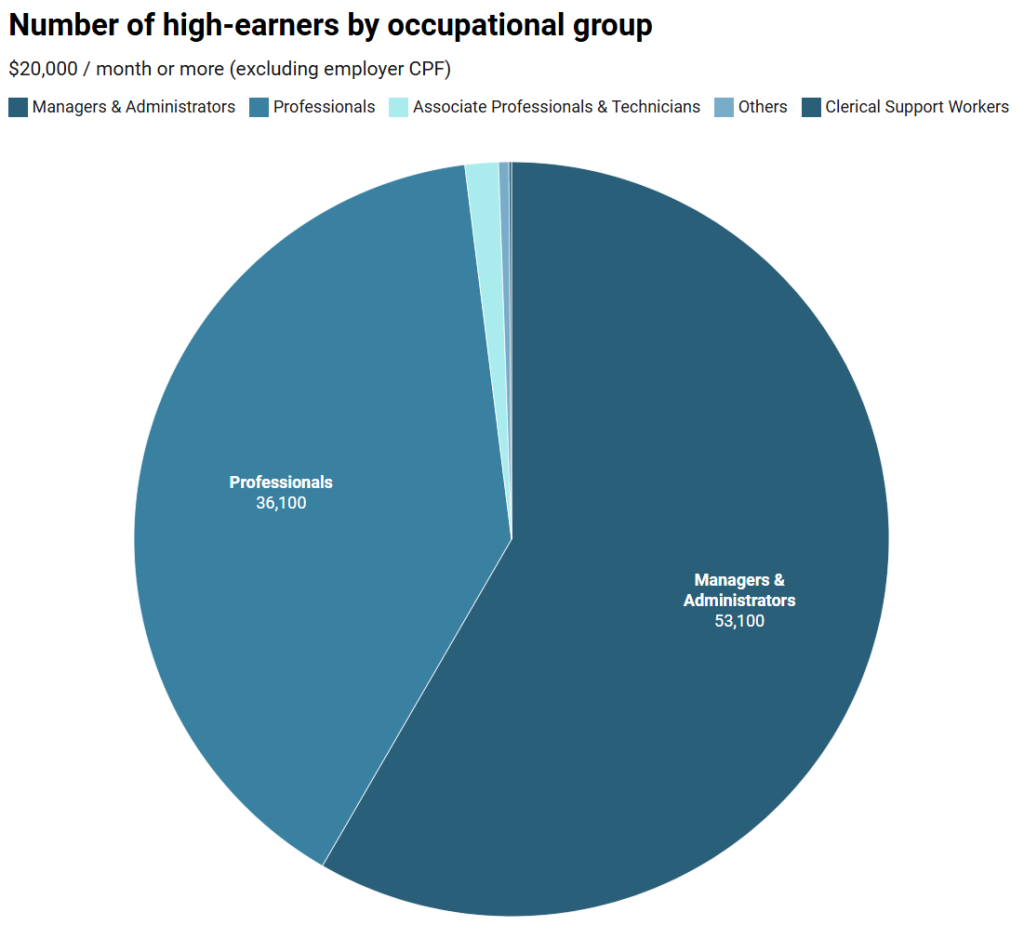Disclaimer: Unless otherwise stated, any opinions expressed below belong solely to the author. Data comes from the Ministry of Manpower. Salary figures exclude employer’s CPF contributions.
Whether we like it or not, our professional lives are about climbing the financial ladder over time, starting as well off as we can and then finding our way up to make ever more money to support our lifestyles and our families.
The latest reported median income from work per employed resident is about S$5500 per month, and S$11,300 per household.
But who wants to stay in the middle?
The highest income bracket reported by the Ministry of Manpower is “S$20,000 or over,” capturing the best-paid workers in Singapore.
So, what does it take to enter that group? What do you have to do? Who pays that much? And what are your chances?
Let’s take a look:
Get a degree
While the importance of formal, academic education in the recruitment process is dropping very quickly, the fact that it doesn’t feature highly among mandatory requirements of an ever-growing number of employers doesn’t mean it is a waste of time.
In fact, there’s hardly a better path to increasing your chances of getting paid a lot of money than graduation from a university. As I reported in one of my past articles, the median salary for degree holders in Singapore has already hit S$8,650 per month—more than S$3000 above the national average.
One in twelve, or 8.5%, are paid at least S$20,000. Diploma or other professional qualification holders are around eight times less likely to make this much, and those chances drop to under 1% for lower education levels.

Soft skills pay
There are close to 400,000 managers and administrators in Singapore, and more than 53,000 of them are in the highest paid group (comprising 58% of the total). It means that 13.4% of all managers, or 1 in 7.5, take home S$20,000 or more—by far the largest proportion in any occupational group.

For professionals (i.e. people skilled at a particular job but without managerial responsibilities), that percentage drops to just 6% and is almost zero for every other group.
In other words, if you want to be paid nearly a quarter of a million dollars per year, you first have to be highly qualified at your job, and if you want to increase your chances further, you need to work on the soft skills required to take on a managerial role in the company.
Industries to join
Finally, as we all well know, the nature of the business determines your share of the value, which you receive as your salary. Some businesses pay much better than others, though most may not provide as many opportunities to make such sums of money.
Here’s how they rank:
| Rank | Industry | Percentage of workers paid S$20,000 per month or more |
| 1 | Financial & Insurance Services | 12.60% |
| 2 | Information & Communications | 7.10% |
| 3 | Professional Services | 6.70% |
| 4 | Health & Social Services | 3.90% |
| 5 | Wholesale & Retail Trade | 3.70% |
| 6 | Manufacturing | 3.40% |
| 7 | Real Estate Services | 3.30% |
| 8 | Transportation & Storage | 2.40% |
| 9 | Arts, Entertainment & Recreation | 2.20% |
| 10 | Public Administration & Education | 2.00% |
| 11 | Construction | 1.80% |
| 12 | Other Community, Social & Personal Services | 1.40% |
| 13 | Administrative & Support Services | 1.30% |
| 14 | Accommodation & Food Services | 0.40% |
Unsurprisingly, financial & insurance services top the list, with 1 in 8 employees earning S$240,000 per year or more. The more money you deal with, the bigger the value of your slice of the pie.
It is followed by IT and professional services (which are a backbone of all successful businesses, after all), at close to 7% of their respective workforces.
In other words, you should either be a techie or join the corporate sector, preferably dealing with money.
Then there’s a bit of a gap. Only one in twenty-five employed in healthcare is in this income group, though it’s likely that we would see a much higher portion among highly qualified doctors, if we had a more granular breakdown for the sector.
The numbers continue to fall further for all other industries, where really just very few can make that kind of money. It’s not impossible, but it’s very rare.
On the one hand, in total, there are over 90,000 people in Singapore in this income group, which sounds like quite a lot. On the other hand, however, you really have to fit very specific conditions and choose your business wisely if you want to have a decent chance to ever ascend to it.
I hope the information gathered here helps you on your way there.
- Read other articles we’ve written on job trends here.
Featured Image Credit: Ben Thai/ Unsplash










